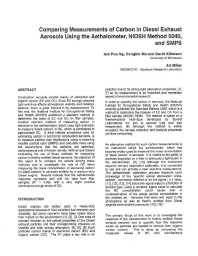Mining Publication: Comparing Measurements of Carbon in Diesel Exhaust Aerosols Using the Aethalometer, NIOSH Method 5040, and SMPS
Original creation date: April 2007
Combustion aerosols consist mainly of elemental and organic carbon (EC and OC). Since EC strongly absorbs light and thus affects atmospheric visibility and radiation balance, there is great interest in its measurement. To this end, the National Institute for Occupational Safety and Health (NIOSH) published a standard method to determine the mass of EC and OC on filter samples. Another common method of measuring carbon in aerosols is the aethalometer, which uses light extinction to measure "black carbon" or BC, which is considered to approximate EC. A third method sometimes used for estimating carbon in submicron combustion aerosols, is to measure particle size distributions using a scanning mobility particle sizer (SMPS) and calculate mass using the assumptions that the particles are spherical, carbonaceous and of known density. With an eye toward evaluating the use of these methods for measuring carbon in freshly emitted diesel aerosols, the objective of this paper is to compare the results among these methods and to investigate the role of OC when measuring the mass concentration of elemental carbon (or black carbon) in aerosols emitted by a medium-duty Diesel engine. Results indicate that the aethalometer response correlates well with the data from filter samples (R2 = 0.99), with a very slight positive interference at high levels of OC.
Authors: IP Ng, H Ma, DB Kittelson, AL Miller
Peer Reviewed Journal Article - April 2007
NIOSHTIC2 Number: 20033024
SAE Technical Paper Series 2007-01-0334, 2007 Apr :1-10
See Also
- Characterization of Nanometer and Ultrafine Diesel Aerosols in the Underground Mining Environment
- Diesel Aerosols and Gases in Underground Metal and Nonmetal Mines
- Diesel Aerosols and Gases in Underground Mines: Guide to Exposure Assessment and Control
- Effects of Diesel Exhaust Aftertreatment Devices on Concentrations and Size Distribution of Aerosols in Underground Mine Air
- Effects of Sintered Metal Diesel Particulate Filter System on Diesel Aerosols and Nitric Oxides in Mine Air
- Evaluation of a Wearable Monitor for Measuring Real-time Diesel Particulate Matter Concentrations in Several Underground Mines
- Examination of Diesel Aftertreatment Systems at NIOSH Lake Lynn Laboratory
- Real-time Diesel Particulate Monitor for Underground Mines
- Real-Time Estimation of Elemental Carbon Emitted from a Diesel Engine
- Toward developing a new occupational exposure metric approach for characterization of diesel aerosols
- Content source: National Institute for Occupational Safety and Health, Mining Program


 ShareCompartir
ShareCompartir
